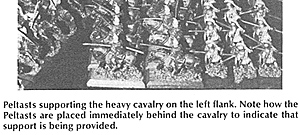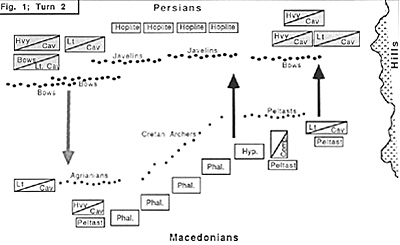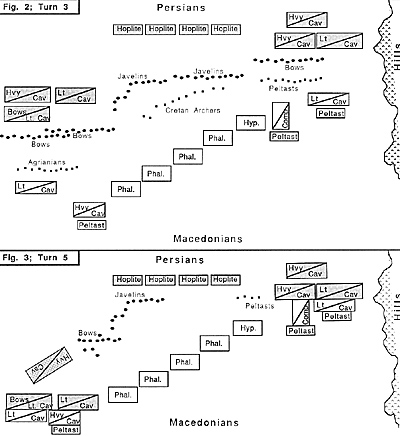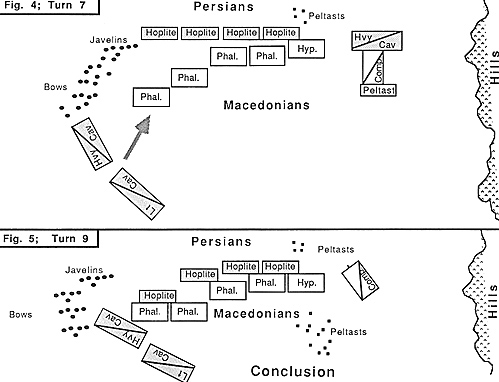
Last issue, I submitted some ideas regarding the accuracy of simulation in ancient wargaming. This issue, a game based on those concepts is demonstrated. TACTICA embraces a wide spectrum of the ancient period, but unlike other rules, they are designed to simulate battles between historical opponents only. Consistent with this idea, pre-designed orders of battle are supplied for each army (25 army rosters are included with the game); no points system is used and the armies are not subject to modification in any way. This creates a solid identity for each army and players never have to wonderwhat unusual admixture is goingto appear across the table. The orders of battle are based on historical army compositions and have been endlessly playtested to insure a fair game.
The battle which follows, between the Macedonians and Persians, was fought earlier this year by members of The New York Wargamers Association using the TACTICA system.
Macedonian and Persian Order of Battle
PROBLEMS FACING THE GENERALS
 From the Macedonian point of view, the main Persian threat lies in its abundant and powerful cavalry arm, which is both more numerous and stronger-on a unit for unit basis - than their Macedonian counterparts. To support the cavalry there are numerous auxiliaries, especially the skirmisher bow units which can wreak havoc among unsupported enemy cavalry units. Lastly, there is the mercenary hoplite battleline. These are troops of a high fighting quality and when supported properly, are capable of holding their own against the Macedonian phalanx.
From the Macedonian point of view, the main Persian threat lies in its abundant and powerful cavalry arm, which is both more numerous and stronger-on a unit for unit basis - than their Macedonian counterparts. To support the cavalry there are numerous auxiliaries, especially the skirmisher bow units which can wreak havoc among unsupported enemy cavalry units. Lastly, there is the mercenary hoplite battleline. These are troops of a high fighting quality and when supported properly, are capable of holding their own against the Macedonian phalanx.
As the Persian sees it, there are two ways in which the Macedonian can win. First, there is a large and powerful Phalanx battleline, which if permitted to cross the field in good order, can eventually grind down the mercenary hoplites. The second, and possibly more dangerous threat is the Macedonian cavalry, led by the Companions and the light infantry Peltasts which support the cavalry arm. In these rules the light infantry peltast units are special because they can function either as a skirmisher, or as a massed formation (they can fight against cavalry when they are massed only). If the Macdonian plays it right, this cavalry/peltast combination can stop, or tie up, the Persian cavalry masses.
Ideally the Persians must overwhelm the Macedonian cavalry with a combination of cavalry and bow fire, and then descend on an open wing of the phalanx. As a secondary tactic, they can try to shoot up the Macedonian phalanxes seriously enough for their hoplites to press home. In this approach, some of the light cavalry may be used early, to drive in the Macedonian skirmisher screen.
The Macedonian must at least neutralize the Persian horsemen with a combination of their own cavalry and peltasts, but, he must also have enough skirmishers on hand to protect the phalanxes and the cavalry from the Persian archers. Therein lies the razor's edge on which the Macedonian walks; the real skill is using the cavalry and auxiliaries wisely, knowing when and how many peltasts to put into skirmisher, as a screen, and how many to fight in a massed formation, to stop the Persian cavalry. The Macedonian army works well only when all its parts are used in careful coordination. It is not a matter of simply walking the phalanx across the field and bowling over the opposition. Macedonian players learn this lesson very quickly.
 Figure one shows the positions of the armies at the end of turn two. In TACTICA, the second turn is called the Deployment Turn. Up through and including the Deployment Turn, units are permitted to move, somewhat flexibly, in columns of maneuver. From the end of the Deployment Turn on, the battle units (especially the heavy infantry units) are considered committed and must move in a controlled and rigid manner in imitation of their historical counterparts. Once deployed, the heavy infantry units are not permitted to wheel, orto left and right face after turn two; except for the more flexible light horse, most cavalry units in this period can change direction by executing time consuming wheels only.
Figure one shows the positions of the armies at the end of turn two. In TACTICA, the second turn is called the Deployment Turn. Up through and including the Deployment Turn, units are permitted to move, somewhat flexibly, in columns of maneuver. From the end of the Deployment Turn on, the battle units (especially the heavy infantry units) are considered committed and must move in a controlled and rigid manner in imitation of their historical counterparts. Once deployed, the heavy infantry units are not permitted to wheel, orto left and right face after turn two; except for the more flexible light horse, most cavalry units in this period can change direction by executing time consuming wheels only.
In addition, to insure that the phalaxes move as a collective body, in the same direction, no heavy infantry unit can move more than 4" away from the heavy infantry unit adjacent to them. Historically, since heavy infantry units moved in close proximity to one another, this rule prevents phalanxes from operating independently and being shifted around as the situation requires. With these restrictions, players are forced to create sound original plans which anticipate enemy actions. Their plan had better take into account the vulnerable flanks of the battleline.
TURN TWO ANALYSIS
The Macedonian is weighted heavily on his right and obviously intends a classic echelon attack. To make his right hand attack overwhelming, he has placed only just enough troops to protect the echeloned left. He is hoping to crush the Persian left, while simply tying down the Persian right.
Except for a greater concentration of archers on his right, the Persian has chosen a balanced deployment. In this disposition, the Persian cavalry is likely to achieve a superiority on at least one wing. It is clear from the Macedonian deployment, that the Persian must turn the Macedonian left before his own left is cracked.
 TURN THREE ANALYSIS
TURN THREE ANALYSIS
As anticipated each side is pressing his strong wingand buyingtime with the weak flank. Not wanting to advance beyond the support of their own peltasts, the Macedonian right flank cavalry is moving slowly but steadily forward; the peltasts are shown keeping pace to the rear of the cavalry. The phalanx is trudging forward to strike the mercenary hoplites.
On the Macedonian left, the Agrianian javelins are outnumbered and unable to prevent the Persian foot archers and horse archers from inflicting serious losses on the Macedonian cavalry. To make matters worse, the Persian player is rolling hot. The Persian battleline is held back, as is the Persian left flank cavalry. Note that since the Persian right flank is carried by cavalry alone (with supporting bow fire), their attack and any subsequent exploitation can be executed quickly.
TURN FIVE ANALYSIS
With the preliminary skirmishing phase over, the Persian right engages the Macedonian left. As stated, the Macedonian cavalry has been weakened by the Persian archers and even with the peltasts in support, will not be able to hold the Persian horsemen for as long as hoped. Once the Macedonian left is destroyed, nothing is available to prevent the Persian horse from descending on to the rear of the Phalanx. Aware of this, the Macedonian attempts an all-out attack with the phalanx, trying to create distance between what will be the victorious Persian horse and the open left flank and rear of the phalanx. The hope is that the phalanx can break the Greek mercenaries before the Persian horse can descend from the rear.
On the Macedonian right the Companions, supported by some light horse and floods of peltasts, are making headway against the Persian horsemen. Note the Persian heavy cavalry unit in the left rear, standing by to plugwhatwill shortly be a gap in the line when the Macedonians drive in the leading Persian cavalry elements; note that no similar reserve exists on the Macedonian left.
A unique feature of the TACTICA system is how the close cooperation between light infantry (peltasts) and cavalry is represented. Massed light infantry stationed to the rear of, and in base to base contact with, friendly cavalry is said to be functioningin Close Support. When supporting in this fashion, any casualties inflicted by either missile fire, or melee, must be divided evenly against the cavalry and peltasts. However, the cavalry and the peltasts will COMBINE their offensive capabilities against any enemy cavalry units they face in melee. The cavalry and peltasts are now operating, in essence, as a mixed unit. See photo example. Note that in these rules, armies from different eras, such as the armies of the near east, are permitted to employ this light infantry/cavalry tactic as well.
 TURN SEVEN ANALYSIS
TURN SEVEN ANALYSIS
By this time in the battle, the Persian right flank cavalry, with some loss, has defeated the Macedonian left and is now preparing to descend on the phalanx from the rear. The elite Hypaspists have slammed into the mercenary hoplites, who are, for the moment, holding their own. The Macedonian right has defeated the leading Persian cavalry forces and is now engaging the last of the Persian reserve horse. Although the Macedonians will defeat this unit as well, it is unlikely that they will be able to flank the hoplites before the battle is decided. Will the hoplites hold the Macedonian phalanx long enough to allow the Persian cavalry to turn the tide?
ENDGAME ANALYSIS
As the Macedonian phalanxes come up in support of the Hypaspists, the mercenary hoplites on the Persian left are just about ready to cave in. However, the Persian cavalry has at last descended on the rear of the Phalanx. At this point it is necessary to point out how melees are resolved in TACTICA, and how games are won and lost.
MELEE RESOLUTION
In the TACTICA system, melees are not resolved in a random order. Instead, a mechanic known as Melee Priority is employed to determine the order in which melees are adjudicated. Based on the priority system, any Flank or Rear attacks are resolved before any other melees; the results are immediately applied. Using this game as an example, although the mercenary hoplites on the Persian left are ready to break, the melee which occurs first is the area where the Persian cavalry has hit the phalanx in the rear.
VICTORY CONDITIONS
Each army in the game has a set number of key battle unit(s) which it can afford to lose before the army loses the battle. In the era in which this game has simulated, a single dynamic breach of the heavy infantry battleline was sufficient to decide the battle; whichever army was the first to visit this calamity on its opponent was usually the victor. Therefore, the first army to lose ONE of its heavy infantry battleline units will be the loser, regardless of what is happening elsewhere on the battlefield. Since the Persian cavalry attack on the rear of the phalanx was resolved first (as per Melee Priority), and because such attacks were in actuality totally devastating in their effect, the Persians broke the phalanx and won the game before the other melees were resolved. If the Persian cavalry had arrived even one turn later, the hoplites would probably have been overwhelmed. In other game types, such as cavalry actions, armies need to lose several units before losing the game. This is because without a heavy infantry battleline, an entirely different style of fighting must be represented.
SOME NOTES ON PLAY
During this reenactment, I have purposely avoided explaining the minute details of the rules necessary to play the game. However, to give you a general idea of the mechanics used, please note the following points.
TACTICA stresses basic tactical theory and a sound original battleplan. The troop types employed are few in number and are defined by their historical battlefield usage. These units are rated for their overall combat worthiness; the game never degenerates into a weapon type/armor class sub-game. Morale checks are made only when certain dyanamic events require it; these checks are infrequent, instantly adjudicated, and require no lengthy list of modifiers. Six-sided dice are used for all functions.
The game is of a move-countermove nature based on initiative. No evading rules are used, since units are either moved too close to the enemy and get caught, or they stay at a safe distance and survive. All traces of gimmickry, exotic troop-types, weapons or tactics have been avoided -- with all due apologies to flaming pig supporters and two handed axe fanatics! Above all, the game represents a return to simplicity, and is exciting to play. Since movement is strictly controlled after deployment, most games move quickly, taking about three hours in total.
ED NOTE: The rules are called: TACTICA - A new approach to Ancient Wargaming, which is currently in production and will be available in the late summer or early fall.
Back to Table of Contents -- Courier Vol. VIII No. 6
To Courier List of Issues
To MagWeb Master Magazine List
© Copyright 1989 by The Courier Publishing Company.
This article appears in MagWeb (Magazine Web) on the Internet World Wide Web.
Other articles covering military history and related topics are available at http://www.magweb.com